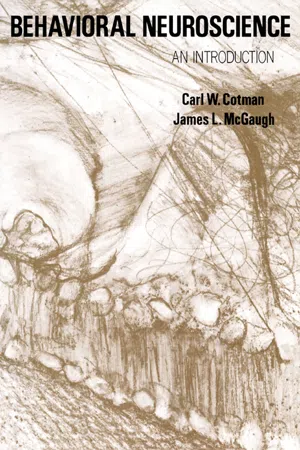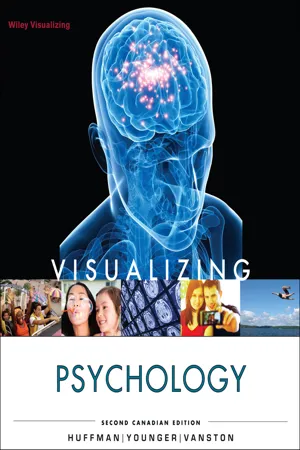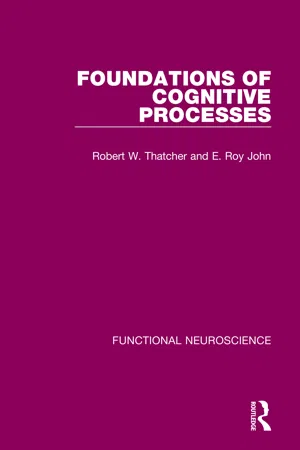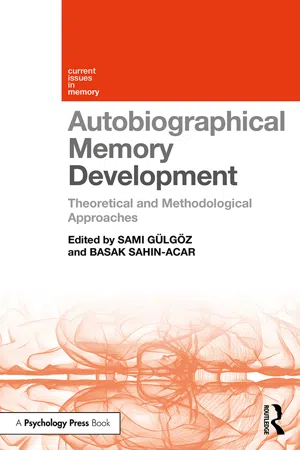Psychology
Biological Bases of Memory
The biological bases of memory refer to the physical structures and processes in the brain that underlie the encoding, storage, and retrieval of memories. This includes the role of neurotransmitters, synaptic connections, and specific brain regions such as the hippocampus and amygdala. Understanding the biological foundations of memory helps to explain how memories are formed and how they can be affected by brain injuries or diseases.
Written by Perlego with AI-assistance
Related key terms
1 of 5
9 Key excerpts on "Biological Bases of Memory"
- eBook - ePub
Behavioral Neuroscience
An Introduction
- Carl W. Cotman, James L McGaugh(Authors)
- 2014(Publication Date)
- Academic Press(Publisher)
This chapter describes complex learning and memory in humans. Learning and memory involve a complex set of processes by which experiences alter the nervous system in ways such that the changes endure and effect subsequent experience and behavior. Memory does not consist simply of responses made during learning. Humans readily learn and perform skills such as language in which responses occur in novel sequence. The memory can be indicated by speaking, dialing, pushing buttons or in other ways, such as writing or simply identifying the sequence of numbers as the correct number. The memory is formed rapidly, is usually transient, but, with rehearsal or repetition, can become long-lasting. This chapter reviews approaches to the neuroBiological Bases of Memory. The chapter discusses the effects of brain lesions on retention and neurobiological correlates of memory.I. Approaches to the NeuroBiological Bases of Memory II. Effects of Brain Lesions on Retention III. Neurobiological Correlates of Memory IV. Neurophysiological Correlates of Learning V. EEG Studies of Learning VI. Unit Studies of Learning VII. Evoked Potentials VIII. Neurochemical Correlates of Training IX. Experimental Modulation of Memory Storage Processes X. Retrograde Amnesia XI. Effects of Direct Electrical Stimulation of the Brain XII. Facilitating Effects of Brain Stimulation XIII. Effects of CNS Stimulants on Memory XIV. Effects of Inhibition of RNA and Protein Synthesis XV. Endogenous Modulators of Memory Storage XVI. Peripheral Catecholamines XVII. Sleep and Memory Modulation XVIII. Brain Pathology and Memory XIX. The Amnesic Syndrome: An Introduction XX. Retrograde Amnesia in Human Patients XXI. Neuropathology XXII. The Psychological Defect in Amnesia XXIII. The Organization of Memory in the Brain XXIV. Summary Key Terms General References ReferencesLearning and memory involve a complex set of processes by which experiences alter the nervous system in ways such that the changes endure and effect subsequent experience and behavior. The problem of understanding the neuronal basis of learning and memory is not a simple one of determining the neuronal residue of experience. In order to understand memory we will ultimately need to know many things, including how experiences are selected for storage, how they are stored, how they are integrated with other memories, how they are retrieved and how they lead to changes in behavior. Neuronal plasticity is only one aspect of learning and memory. - eBook - PDF
- Siri Carpenter, Karen Huffman(Authors)
- 2012(Publication Date)
- Wiley(Publisher)
As a result, children living in these cultures have better memories for information that is related through stories than do other children. Can you think of other ways in which culture might influence memory? Biological Bases of Memory 189 number of biological changes occur when we learn something new. Among them are neu-ronal and synaptic changes and hormonal changes. We discuss these changes in this section, along with the questions of where memories are located and what causes memory loss. Neuronal and Synaptic Changes We know that learning modifies the brain’s neural net-works (Chapters 2 and 6). As you learn to play tennis, for example, repeated practice builds specific neural “pathways” that make it easier and easier for you to get the ball over the net. This long-term potentia-tion (LTP) happens in at least two ways. First, as early research with rats raised in “enriched” environ-ments showed (Rosenzweig, Bennett, & Diamond, 1972), repeated stimulation of a synapse can strengthen the syn-apse by causing the dendrites to grow more spines (Chap-ter 6). This results in more synapses, more receptor sites, and more sensitivity. Second, when learning and memory occur there is a measurable change in the amount of neurotransmitter re-leased, which thereby increases the neuron’s efficiency in message transmission. Research with Aplysia (sea slugs) clearly demonstrates this effect ( Figure 7.8 ). Further evidence comes from research with ge-netically engineered “smart mice,” which have extra receptors for a neurotransmitter named NMDA (N-methyl- d-aspartate). These mice performed significantly better on memory tasks than did normal mice (Tang et al., 2001; Tsien, 2000). 3. Identify some brain areas involved in memory. 4. Explain how injury and disease can affect memory. Biological Bases of Memory LEARNING OBJECTIVES 1. Describe two kinds of biological changes that occur when we learn something new. - eBook - PDF
- Catherine A. Sanderson, Karen R. Huffman(Authors)
- 2019(Publication Date)
- Wiley(Publisher)
Summarize the biological factors involved in memory. • Describe the synaptic and neurotransmitter changes that occur when we learn and remember. • Review how our memories are processed and stored. • Explain how emotional arousal affects memory. • Discuss the biological factors in memory loss. Real World Application Questions [AQ4] How might exposure to pornography interfere with memory? [AQ5] Can physical fitness help prevent dementia? Having discussed the nature of memory and the various models of how it is organized, now we’ll explore the Biological Bases of Memory—the synaptic and neurotransmitter changes, where memories are processed and stored, the effects of emotional arousal, and the biological factors in memory loss. Synaptic and Neurotransmitter Changes Do you recall from Chapters 2 and 6 how learning and memory modify our brains’ neural net- works? When you are learning to play a sport like tennis, for example, repeated practice builds specific neural pathways that make it progressively easier for you to get the ball over the net. These same pathways later enable you to remember how to play the game. These changes, called long-term potentiation (LTP), happen in at least two ways. First, early research with rats raised in enriched environments found that repeated stimulation of a synapse strengthens it by causing the dendrites to grow more spines (Rosenzweig et al., 1972). This repeated stimulation further results in more synapses and receptor sites, along with increased sensitivity. Second, when learning and memory occur, there is a measurable change in the amount of neurotransmitter released, which increases the neuron’s efficiency in message transmission. Research with Aplysia (sea slugs) clearly demonstrates this effect (Figure 7.16). Further evidence comes from research with genetically engineered “smart mice,” which have extra receptors for a neurotransmitter named NMDA (N-methyl-d-aspartate). - eBook - PDF
- Karen R. Huffman, Catherine A. Sanderson(Authors)
- 2013(Publication Date)
- Wiley(Publisher)
As a critical thinker, can you explain why this ability might provide an evolutionary advantage? © Wolfgang Pölzer/Alamy Inc. Biological Bases of Memory RETRIEVAL PRACTICE While reading the upcoming sections, respond to each Learning Objective in your own words. Then compare your responses with those found at www.wiley.com/college/huffman. 1 DESCRIBE two kinds of biological changes that occur when we learn something new. 2 EXPLAIN the effect of hormones on memory. 3 IDENTIFY some brain areas involved in memory. 4 EXPLAIN how injury and disease can affect memory. A number of biological changes occur when we learn something new. We discuss these changes in this section, along with the questions of where memories are located, and what causes memory loss. Neuronal and Synaptic Changes We know that learning modifies the brain’s neural networks (Chapters 2 and 6). As you learn to play tennis, for example, repeated practice builds specific neural path- ways that make it easier and easier for you to get the ball over the net. This long- term potentiation (LTP) happens in at least two ways. First, as early research with rats raised in enriched environments showed (Rosenzweig et al., 1972), repeated stimulation of a synapse can strengthen the syn- apse by causing the dendrites to grow more spines (Chapter 6). This results in more synapses, more receptor sites, and more sensitivity. Second, when learning and memory occur, there is a measurable change in the amount of neurotransmitter released, which thereby increases the neuron’s efficiency in message transmission. Research with Aplysia (sea slugs) clearly demonstrates this effect (Figure 7.13) . LEARNING OBJECTIVES Long-term potentiation (LTP) A long-last- ing increase in neural excitability, which may be a biological mechanism for learning and memory. chapter 7 MEMORY 194 - eBook - PDF
- Karen R. Huffman, Alastair Younger, Claire Vanston(Authors)
- 2013(Publication Date)
- Wiley(Publisher)
Describe two kinds of biological changes that occur when we learn something new. 2. Identify the primary brain areas involved in memory. 3. Explain how injury and disease can affect memory. M and easier for you to get down the mountain without falling over and breaking your neck. Research has shown this long-term potentiation (LTP) happens in at least two ways. First, as early research with rats raised in enriched environ- ments showed (Rosenzweig et al., 1972; Chapter 6), repeated stimu- lation of a synapse strengthened the synapse by causing the dendrites to grow more spines. Spines are knobby outcrop- pings on dendrites, and more of them means more synaps- es, more receptor sites, and more sensitivity. The neuron is said to be more sensitive because the action potential can long-term potentiation (LTP) Long-lasting increase in neural excitability caused by repeated neural input. Believed to be the biological basis of learning and memory. Biological Bases of Memory 195 Hormonal Changes and Memory Emotional arousal often leads to stronger memories. When stressed or excited, we naturally produce fight-or-flight hormones, such as epinephrine and cortisol (Chapter 3), that arouse and energize the body to deal with the threat. These hormones in turn affect the amygdala, a brain struc- ture involved in emotion (Chapter 2), which then signals the hippocampus and cerebral cortex. The activation of these brain regions is essential for laying down strong mem- ories of the event. They’re important in situations of threat, as remembering what happened will enhance survival for the organism should the situation present itself again. Research has shown that direct injections of epinephrine or cortisol or electrical stimulation of the amygdala increases the encoding and storage of new information (Hamilton & Gotlib, 2008; Jackson, 2008; van Stegeren, 2008). - eBook - PDF
- Werner K. Honig, P. H. R. James, Werner K. Honig, P. H. R. James(Authors)
- 2013(Publication Date)
- Academic Press(Publisher)
Second, it could be that in some cases the changes are due to alterations in motivational state (e.g., arousal) produced by the training experience. Third, it may be impossible to obtain the evidence essential for deciding whether the criteria have been met. For example, if an experience 5. MODIFICATION OF MEMORY STORAGE PROCESSES 217 produces both transient (i.e. short-term memory) effects and durable (i.e., long-term memory) effects, the transient neurobiological change underlying short-term memory would be rejected as a basis of memory according to the criteria above simply because the behavioral evidence of memory (i.e., long-term memory) outlasts the neurobiological transient. In view of these difficulties, it seems unlikely that an understanding of the neuroBiological Bases of Memory will result solely from correlational studies. II. Experimental Analysis of Time-Dependent Processes of Memory Storage An alternative method of approaching the problem of the bases of memory, and one currently employed in numerous laboratories, is that of attempting to modify memory processes by administering treatments which affect central nervous system functioning. This approach is based on the assumption that an understanding of the nature of the effect of the treatment on memory (i.e., amnesia or facilitation of learning), considered together with knowledge of the mechanisms of action of the treatment, might provide important clues to the neurobiological process underlying memory. In the remainder of this chapter we shall examine the results and implications of some of these investigations. We shall conclude by examining several models of memory storage growing directly out of this research, which we feel may prove to be important tools for future research. - eBook - ePub
- Robert W. Thatcher, E. Roy John(Authors)
- 2021(Publication Date)
- Routledge(Publisher)
With the advent of methods of classical and instrumental conditioning around the turn of the century and the development of more or less standardized procedures for establishing a specified conditioned response, it became possible to make quantitative statements about the extent to which an experimental manipulation affected the acquisition or retention of a new behavior. Consequently, a great proliferation of studies on the effects of brain lesions upon learning and memory occurred in the first half of the twentieth century.After World War II, a new genre of studies of learning and memory appeared. The use of sensitive amplifiers and chronically implanted electrodes permitted observation of electrophysiological phenomena in the brains of animals as they acquired and performed conditioned responses. More recently, such techniques have become further refined so as to permit the continued observation of groups of neurons or even single neurons under such conditions. The development of special purpose computers and laboratory oriented general purpose minicomputers during the last 15 years has enabled high precision and sensitivity to be achieved in such studies and has provided a great impetus to investigations of the neurophysiology of learning and memory, resulting in a voluminous literature.The biochemistry of memory has been the last area to come under systematic investigation. Almost all of the numerous studies into the biochemical reactions involved in learning and the formation of memory have occurred during the last 10 years. This field has grown in leaps and bounds and now occupies the attention of a large number of investigators.Our discussion of the brain mechanisms of learning and memory will be organized functionally, according to the following questions: (1) What is the material basis of memory and how is it constructed? (2) Where is memory? (3) How do we remember?I. What is the Basis of Memory and How Is It Made?
A. The Consolidation Phase
As Socrates argued, an experience must leave a residue in the brain. Whether that residue be a new capability or only the recollection of a pattern of sensations, something must be built which serves as the physical basis for storage of the details of a transient process. One of the most useful lines of research into the mechanisms of the storage process has arisen from the phenomenon of consolidation - eBook - PDF
- Karen R. Huffman, Katherine Dowdell, Catherine A. Sanderson(Authors)
- 2017(Publication Date)
- Wiley(Publisher)
Self-Test 1. Briefly explain the decay theory of forgetting. 2. The theory suggests that forgetting is caused by two com- peting memories, particularly memories with similar qualities. a. decay b. interference c. motivated forgetting d. encoding failure 3. The effect suggests that people will recall information presented at the beginning and end of a list better than infor- mation from the middle of a list. a. recency b. latency c. serial position d. primacy 4. Distributed practice is a learning technique in which . a. students are distributed (spaced) equally throughout the room 7.3 Biological Bases of Memory LEARNING OBJECTIVES Retrieval Practice While reading the upcoming sections, respond to each Learning Objective in your own words. Summarize the biological factors involved in memory. • Describe the synaptic and neurotransmitter changes that occur when we learn and remember. • Identify the major areas of the brain involved in memory storage. • Explain how emotional arousal affects memory. • Discuss the biological factors in memory loss. So far we have explored the nature of memory and various models of how it is organized. We’ve also examined various theories and factors involved in forgetting. In this section, we’ll explore the Biological Bases of Memory—synaptic and neurotransmitter changes, where memories are stored, the effects of emotional arousal, and the biological factors in memory loss. Synaptic and Neurotransmitter Changes In Chapters 2 and 6, we discussed how learning and memory modify our brains’ neural net- works. For instance, for people learning to play tennis, repeated practice builds specific neural pathways that make it progressively easier to get the ball over the net. These same pathways later enable players to remember how to play the game the next time they go out onto the tennis court. How do these biological changes, called long-term potentiation (LTP), occur? They happen in at least two ways. - eBook - ePub
Autobiographical Memory Development
Theoretical and Methodological Approaches
- Sami Gülgöz, Basak Sahin-Acar, Sami Gülgöz, Basak Sahin-Acar(Authors)
- 2020(Publication Date)
- Routledge(Publisher)
Research on the brain bases of autobiographical memory and its development has been dominated by work on the very first of the criterial elements, namely “access and retrieval” of specific past events. Here the story is relatively well worked out in terms of the neural structures involved, how they function as a network, and even their course of development (described below). The portions of the story that concern the elements that differentiate autobiographical memories from memories of events with less personal relevance and significance are correspondingly shorter and less elaborate.In the balance of this chapter, I outline what is known about the brain bases and development of the most fundamental component of autobiographical memory, namely, access and retrieval of specific past events. I also summarize what is known about the neural correlates and development of other components of autobiographical memory. The latter part of the sketch will by necessity be “light.” I then discuss the consequences of the protracted course of development of the full complement of neural contributors to autobiographical memory, including developmental differences in the rates at which autobiographical memories are forgotten by younger relative to older children, and differences in the narratives that children produce to describe the experiences that they remember. Together, the bodies of research present an emerging – yet still incomplete – picture of the brain bases of autobiographical memory in development.Constructing memory representations: brain bases
The brain basis of autobiographical memory is a distributed network of neural structures each of which has its own developmental course.Structures and networks
Encoding, storing, and later retrieving memories of specific past events depends on a multicomponent neural network that includes structures in the medial-temporal lobes (including the hippocampus), as well as neocortical structures (e.g., Eichenbaum & Cohen, 2001; Manns & Eichenbaum, 2006). The network is schematically represented in Figure 3.1
Index pages curate the most relevant extracts from our library of academic textbooks. They’ve been created using an in-house natural language model (NLM), each adding context and meaning to key research topics.








